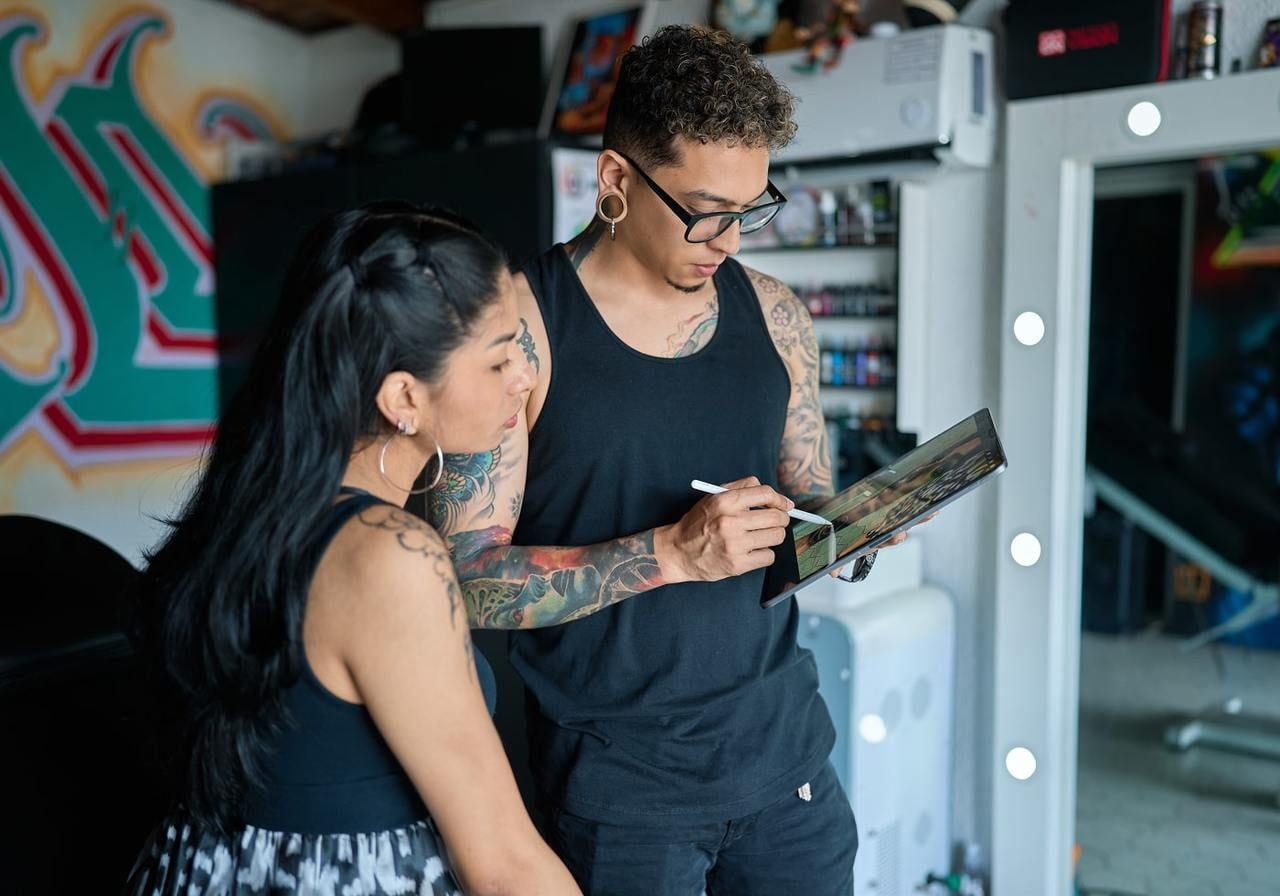Table of contents
Digital art isn’t just a creative outlet – it’s a business opportunity. Unlike traditional art forms, you can sell digital artwork online over and over, reaching a global audience and monetizing your creative talents with low overhead costs.
This article will show you how to sell digital art online. Plus, we’ll cover the different marketing strategies and platforms artists can use to generate a steady income stream.
Key takeaways
-
Explore various artistic styles to find your niche and stand out in a competitive market.
-
Choose the right online platform to match your business goals and target customers.
-
Start with an Etsy shop for easy access to a built-in audience and low setup barriers, then expand to build your own website for full control over branding.
-
Use Printful to turn your digital creations into premium physical products without managing inventory.
-
Promote your digital art online with search engine optimization (SEO) and content marketing to increase visibility and sales.
Why is it worth selling digital art?
Selling digital art is one of the easiest ways to make money online using your creativity. With no inventory, shipping, or restocking involved, you can create once and sell digital products continuously.
It’s a low-risk business model that makes it simple to start selling art online with minimal investment.
Demand is booming across online platforms like Etsy, TikTok Shop, and Amazon. From wall art and digital art prints to downloads and print-on-demand posters, both consumers and businesses are constantly looking for fresh artwork.
Whether you’re a seasoned digital artist or just learning how to sell art online, now’s the time to tap into this growing global market.
Is selling digital art profitable?

Absolutely – selling digital downloads and art can be incredibly profitable when you treat it like a real art business. Here’s how the numbers stack up:
-
Expanding online art market – The global digital art market is expected to hit $5.8 billion by 2025.
-
Multiple income streams – Smart digital artists don’t just sell digital files. They license their digital products, take commissions, sell art prints through print-on-demand services, and offer templates or downloadables on online marketplaces.
-
Low overhead, high ROI – No physical supplies. No shipping hassles. No stock limits. Just upload your digital assets and start generating passive income.
-
Visibility equals sales – Already have an audience on social media platforms? Showcasing your art style through behind-the-scenes posts and storytelling increases your credibility and helps you stand out in the digital art world.
Whether you make digital paintings, vector illustrations, or niche fan art, there’s huge potential to sell art online and grow a strong revenue stream. The key? Treat your creativity like the product it is – and match it with a smart strategy.
How to sell digital art: 5 Steps
Ready to turn your art into income? Here’s a simple, effective path to online sales that doesn’t waste your time or money.
1. Decide what kind of digital art to sell

Selecting a digital format that suits both your skills and customer demand is the first step. There are two directions you can go into:
-
Sell digital downloads – Think printable wall art, social media templates, branding kits, or digital assets like presets, brushes, and overlays for Lightroom or Photoshop.
-
Sell physical art and products – Sell your designs on art prints, posters, t-shirts, mugs, and other items using print-on-demand services like Printful.
Physical products offer more visibility and perceived value. Using Printful’s print-on-demand platform, you can sell everything from digital art prints to apparel without holding inventory or dealing with shipping.
2. Decide where to sell
Some platforms are better for selling directly to consumers, while others help you build a brand over time. Here are your two main options:
-
Marketplaces (Etsy, Amazon, eBay) – Access to existing traffic, but limited branding control and platform fees.
-
Own online store (Shopify, Wix, Squarespace) – Full control, branding, and flexibility, but you’ll need to drive your own traffic.
Here’s a comparison of top Printful integrations for selling digital files and products.
|
Platform |
Fees |
Traffic |
Best for |
|
Etsy |
Free to start, $0.20 listing + 6.5% transaction + ~3% payment processing fees |
High |
Digital downloads, printables |
|
Shopify |
$39/mo subscription + 2.9%-4% + $0.30 order fees |
High (platform-wide) |
Branded online store, scalability |
|
Wix |
$29/mo + platform transaction fees |
Medium |
Visual showcase of digital art |
|
Squarespace |
$23/mo + payment processing fees (0% transaction fee for certain plans) |
Medium |
Portfolios, digital art files |
|
Gumroad |
Free to start, 9% + $0.30 per sale |
Low-medium |
Simple digital downloads and templates |
|
Big Cartel |
Free for up to 5 products, $15/mo for more |
Low-medium |
Niche creators, physical art |
|
Square Online |
Free to start, 2.9% + $0.30 per sale |
Medium |
Quick setup, print-on-demand storefront |
|
WooCommerce |
Hosting costs, transaction fees from 2.9% + $0.30 with WooPayments |
Medium-high (dependent on your SEO strategy) |
Online art sales, advanced platform flexibility |
|
TikTok Shop |
Free to start, ~6% referral fee + processing + fulfillment if applicable |
High (content-driven) |
Video-first audience, impulse-driven sales |
If you’re not sure where to start, Etsy and Shopify are standout options. Etsy gives you instant exposure, while Shopify gives you full control.
If you’re using Printful, all of these platforms connect seamlessly for automated order fulfillment of your physical art prints and products.
3. Price your products
Selling digital art profitably relies on smart pricing. Here’s how to approach it:
-
Digital downloads – Common price ranges are $2.99 to $25, depending on complexity, exclusivity, and usage rights. For example, a minimalist printable might sell for $5, while a complete brand kit could go for $30.
-
Print-on-demand products – Price it based on the product’s base cost, then add your markup. A standard 12×16 art print might cost $10 to produce and sell for $25-$40, depending on your branding and niche.
Don’t underprice just to drive sales. Build in value through quality, presentation, and buyer experience. Consider bundles or tiered pricing to appeal to both casual buyers and loyal customers.
4. Market your business
Creating great digital products is only half the job – you need to get noticed. Use a combination of free and paid strategies to reach your audience:
-
Share your process on social media platforms like Instagram, TikTok, or Pinterest.
-
Start an email list on your own website to capture leads.
-
Run targeted ads on Etsy, Pinterest, or Facebook.
-
Use SEO on your online store to show up in search results.
-
Collaborate with graphic designers, influencers, or bloggers for exposure.
Highlight your unique art style and make your brand feel personal and relatable. People aren’t just buying files – they’re buying into a vibe, a story, an aesthetic.
5. Analyze and adjust

Once you start selling digital art, pay attention to what works. Look at your bestsellers, traffic sources, and conversion rates.
Are people finding you through Pinterest? Double down on it. Are t-shirts selling better than wall art? Add more variations.
Track:
-
Sales by product type and platform
-
Customer reviews and feedback
-
Abandoned cart data and drop-offs
This data tells you what to tweak – whether it’s your product line, pricing, marketing, or designs. Treat your digital art business like a living system, not a static shop.


How to make money with digital art?
If you’re wondering what to sell, both physical and digital products offer solid potential. Physical art items often have higher perceived value, while digital goods bring scalability.
Physical products

These are ideal if you want to sell physical art without managing inventory or shipping. A print-on-demand service like Printful handles everything – you just upload the design and collect the profits.
-
Posters and canvas – Great for wall art, especially large illustrations and digital paintings.
-
Custom stickers – Lightweight, giftable, and perfect for bundling or seasonal drops.
-
Custom t-shirts and hoodies – Expand your customer base and turn your art into wearable statements.
-
Socks and phone cases – These quirky, personal products showcase your designs in daily life.
-
Greeting cards and postcards – Easy add-ons for holidays, events, or niche collections.
Digital products
Digital downloads are excellent sources of passive income – create once and sell forever with zero fulfillment hassle.
-
Downloadable art prints – Instant wall decor for buyers who want affordable, printable designs.
-
Coloring pages – Quick to design and easy to expand into a series with strong niche potential.
-
Brushes, textures, and backgrounds – Popular among graphic designers and digital artists.
-
Fonts and typefaces – Always in demand across different artistic styles and creative fields.
-
Icons and vector graphics – Great for UI/UX, branding kits, and commercial use.
You can sell files and physical products side-by-side to diversify your revenue and reach more customers.
Digital art as NTFs
If you’re exploring alternative ways to monetize your art, consider turning your work into crypto art. These are digital files minted as NFTs (non-fungible tokens) and sold on blockchain platforms like OpenSea, Foundation, or SuperRare.
It’s a completely different approach than selling a digital art print – NFTs are one-of-a-kind or limited-edition assets, often bought by collectors rather than casual buyers.
Popular NFT product ideas include:
-
1/1 animated illustrations or short visual loops
-
Audio-visual mashups (ideal for musicians or motion designers)
-
Collectible character designs or avatars for games and metaverses
-
AI-assisted art series with signed metadata and unlockable content
While NFTs aren’t for everyone, they can be a powerful income stream if you already have a dedicated audience or a distinctive, consistent style.
It’s also a great way to build community and give fans the chance to own a piece of your creative world.
How to sell digital art: Tips for success

These expert tips will help you stand out, grow your income, and build a lasting presence in the world of online art sales. Let’s break it down.
1. Focus on what sells
Before designing, check out online galleries and marketplaces where people are actively buying – like Etsy or TikTok Shop. Analyze best-selling categories like digital download packs, physical art prints, or aesthetic templates.
Understanding what sells helps you create targeted, in-demand art instead of aiming in the dark.
Try this:
-
Explore bestsellers on Creative Market, Envato Elements, or Etsy.
-
Use Everbee (Chrome extension) to analyze Etsy listings.
-
Look at Pinterest trends for niche inspiration.
-
Check design trend reports from sites like Behance, Dribbble, or DesignCuts to see what’s gaining traction across digital art forms.
2. Use the right tools
If you want to sell digital art online, you need professional tools that speed up your workflow. This will make your files easier to repurpose across formats.
Popular programs like Procreate, Adobe Illustrator, and Affinity Designer let artists and hobbyists alike create crisp, scalable work.
Recommended tools:
-
Procreate (iPad) – Great for hand-drawn wall art.
-
Adobe Illustrator – Ideal for vector artwork.
-
Canva Pro – Beginner-friendly for templates and bundles.
3. Start with one niche
Many artists try to appeal to everyone – and end up selling to no one. The key is to find a niche that matches your interests and has active buyers.
Whether it’s abstract prints, vintage illustrations, or motivational quote posters, consistency in subject, tone, and style helps you build brand recognition and trust.
How to get started:
-
Browse Etsy subcategories like "boho nursery art"
-
Choose a theme and build 5-10 products around it
-
Add new collections as your store grows
4. Offer both digital and physical products
The smartest creators sell in two formats – downloadable and shippable. Offer digital downloads alongside physical art using a print-on-demand service like Printful.
For example, you can sell canvas prints as well as printable JPEG files, giving customers options while boosting your revenue per design.
Set this up with:
-
Printful to automate printing and shipping
-
Digital file formats like high-res PNG, PDF, or JPG
-
Create mockups for both product types using Placeit
5. Build your own online store

Don’t rely entirely on marketplaces. Launch your own eCommerce store using Shopify, Wix, or WooCommerce to control pricing, branding, and the entire customer experience.
Connect your store to a printing company like Printful to fulfill physical orders without lifting a finger.
Steps to launch:
-
Pick a platform – Shopify is easiest for beginners
-
Add products with Printful’s Shopify integration
-
Set up a blog or gallery to boost SEO and engagement
6. Optimize your listings
If your art isn’t discoverable, it won’t sell. Master SEO for product listings by writing keyword-rich titles, clear descriptions, and tags. Make it easy for buyers and search engines to understand your digital files, especially on platforms like Etsy and Creative Market.
To improve visibility:
-
Use Ubersuggest or Keywords Everywhere to research popular terms
-
Write clear, descriptive titles, like “Printable Retro Wall Art – Digital Download”
-
Include alternate tags like “home decor” or “boho artwork”
7. Promote with purpose
Smart marketing strategies can turn good art into a profitable digital art business. Use platforms where visual content thrives – Instagram, Pinterest, TikTok – and showcase your work, process, and customer stories.
Engage with art enthusiasts and don’t shy away from investing in ads if you’ve found a winning product.
Tactics to try:
-
Post 4-5 times a week on Instagram Reels or Pinterest
-
Use Linktree or Beacons to connect your online store
-
Collaborate with micro-influencers or other designers to grow your reach
How to sell digital art with Printful

Sign up
Create your free Printful account and start building your online store. You don’t need inventory or upfront costs – just your creativity and the drive to turn your art into income.
Pick your products
Choose from posters, canvases, tees, and more. Transform your digital files into tangible physical art with Printful’s print-on-demand service – without dealing with production or shipping.
Apply your designs
Upload your artwork to our Design Maker and place it on products. Whether you’re selling prints or apparel, Printful’s tools help bring your designs to life in just a few clicks.
Sell your art
Connect your account to top eCommerce platforms and marketplaces. Then, use marketing strategies to attract customers, build your brand, and start selling prints to a global audience.


With Printful, sell online and become successful!
If you want a hassle-free way to earn passive income, sell digital art online. With the right tools, strategy, and setup, your digital creations can reach a global audience.
Whether you’re opening an Etsy shop, selling through online stores, or experimenting with different artistic styles, Printful gives you everything you need to turn your ideas into income.
Focus on creating and building your brand – we’ll handle fulfillment, shipping, and production.
FAQ
Yes, digital art sales can be highly profitable with the right niche, audience, and platform. Since you’re selling a digital product, your margins are scalable.
Artists who package and price their work well can earn steady passive income, especially when paired with smart promotion strategies.
You can sell through an online marketplace like Etsy, or build your own website with Shopify or WooCommerce. These platforms support easy uploads, instant file delivery, and offer access to millions of buyers.
Pair it with social media marketing on Instagram, TikTok, and Pinterest to expand reach and drive consistent traffic.
Start with creating digital art, listing it on platforms, and delivering files instantly after purchase. You can sell standalone files or offer them printed on physical items like posters or canvases through print-on-demand services like Printful.
Add mockups, clear product descriptions, and usage guidelines to increase trust and boost conversions.
Popular digital art forms include printable wall art, social media templates, logo kits, and illustrations. Minimalist, boho, vintage, and abstract styles perform well, especially when they fit trending aesthetics.
Niches like tattoo flash, spiritual artwork, and customizable templates also attract strong buyer interest.
Both are created by a graphic designer or illustrator using digital tools, and both can be printed on canvas, posters, or apparel. They may share similar file types, resolution needs, and visual formats.
The difference often lies in intent – digital paintings refer to the standalone artwork itself, while digital prints are designed for reproducibility and distribution.

Zane is a sharp-witted writer with a deep interest in eCommerce, branding, and creative entrepreneurship. With a knack for blending humor, insight, and no-nonsense advice, she crafts engaging content that helps merchants learn and businesses grow. When she’s not dissecting industry trends, she's exploring philosophy, music, and the perfect balance between solitude and connection.





